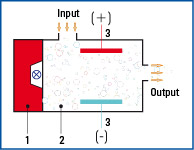The sampled gas flows through a measurement chamber,
that incorporates a UV radiating source and a pair of
electrodes with opposing polarity. The gas molecules
to be detected are ionized by the UV radiation.
The resulting positively charged molecules and the
electrons are attracted to the relevant electrode. The current generated is a measure of the gas concentration.
Using the PID measuring head, volatile organic compounds (VOC) can be measured, the ionisation potential of which is less than the energy in the UV radiating source (10,6 eV), e.g. aromatic hydrocarbons like toluol (C7H8) and xylene (C8H10) as well as chlorinated hydrocarbons like trichloroethylene (CHCl3). The detection of toxic gases like phosphine (PH3) is also possible.

1 = UV radiating source
2 = Test gas
3 = Capacitive charge measurement